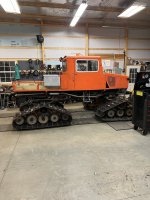As far as removing those PITA screws, we've found our preferred technique is using a small cordless impact wrench and teasing the trigger so it hammers away but doesn't impart much torque at trying to loosen the screw. The hammering action tends to break the rust/corrosion bonds built up over decades, and after a bit of hammering the bond is broken and the fastener will loosen. BUT, Tucker changed from slotted screws to ones with a small hex head and our experience is with those, not the slotted style. I suspect the slotted versions are even less fun to work with...
We no longer use threaded fasteners to secure the floor panels or the side skirts on frame. We use closed-end aluminum POP rivets. They hold well and can be easily drilled out if panel removal is necessary in the future. We do use hex-headed, hardened, self drilling Tek screws on the front frame expanded metal panels.
When one of those PITA screws does break off Scott will grab a heavy duty center punch and about a three pound hammer. He'll then drive the remnants of the broken off screw into the hollow frame. It probably destroys the threads in the frame, but we don't care as we don't need those for the POP rivets.
On a different note: I noticed your transfer case is secured to the frame with socket head capscrews. But there is nothing preventing those from loosening. The 1979 Tucker we had used those same fasteners. The heads were drilled and they were secured with safety wire to prevent them from loosening. The 1980 and later Tuckers we've had used hex bolts and short lengths of rectangular thin-gauge sheet metal. Once the bolts were tightened, the metal was bent over the hex head screw corners, also to prevent them from loosening. On P-Z (Snowzilla) we went back to the earlier method except we used stainless steel cap screws drilled for safety wire (available from McMaster Carr). I have an aviation background and used the safety wire technique used in aviation. Tucker instead had small holes drilled in the brackets the transfer case bolts to, and safety wired each bolt individually to the frame.

Lastly, If you elect to replace your tie rods and rod ends, it would be time well spent to align the steering system per Tucker's procedure. If you count threads, or measure distances, and call it good, you're assuming the alignment was in spec to start with. I forget if it was with P-Z (Snowzilla) or the 1544, but the alignment was off by quite a bit and the factory paint served as witness marks that Tucker had never aligned the machine properly when they built it!
I'm sure I speak for many when I say I'm enjoying your thread, and the great progress you're making....


![image0[12].jpeg](/data/attachments/148/148427-39a3ac6906a2b67d04d5b43860957839.jpg?hash=OaOsaQaitn)
![image2[9].jpeg](/data/attachments/148/148428-ffde0f5ccfd468c96fceac4e14fddd0e.jpg?hash=_94PXM_UaM)
